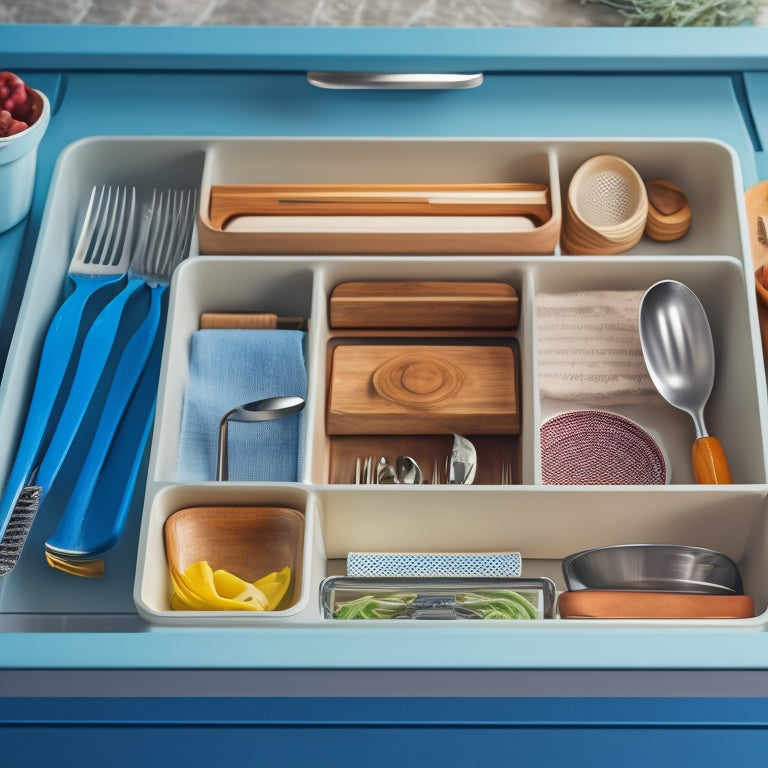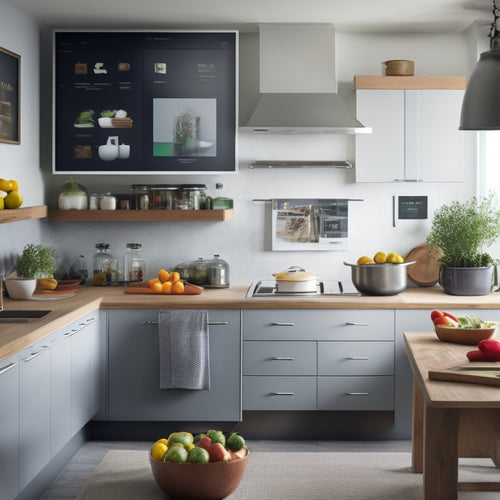
5 Essential Tips for Optimizing Kitchen Drawer Space
Share
You'll be amazed at how much more efficient your kitchen can be by optimizing your drawer space. Start by purging and categorizing your drawer contents, grouping similar items together and getting rid of broken or duplicate items. Then, assign zones for specific items and use dividers to separate them. Choose the right storage containers that fit your zone assignments, and don't forget to implement vertical storage systems to maximize capacity. Finally, make maintaining your drawer organization a habit. By following these essential tips, you'll be on your way to a clutter-free kitchen - and there's even more you can do to take it to the next level.
Key Takeaways
• Purge and categorize drawer contents to get rid of broken, expired, or duplicate items and group similar items together.
• Assign zones for specific items, labeling and separating areas with dividers to quickly locate frequently used items.
• Choose storage containers that fit zone assignments, considering size, layout, and durability to maximize storage potential.
• Implement vertical storage systems, such as adjustable dividers or shelves, to increase drawer capacity and separate items for easy access.
• Maintain drawer organization by setting aside time each week to implement a labeling system and use dividers to separate items.
Purge and Categorize Drawer Contents
Purge and Categorize Drawer Contents
Start by emptying the contents of your kitchen drawers onto a countertop or table, and sort items into categories like baking supplies, cooking utensils, and food storage containers. This step is essential in decluttering efficiently and identifying what you really need.
As you sort, get rid of broken, expired, or duplicate items that are taking up valuable space. Group similar items together, such as all your whisks or measuring cups, to see what you have and what you can consolidate.
Next, categorize items into subgroups, like 'frequently used' and 'occasionally used'. This will help you prioritize what should be easily accessible and what can be stored away. Be ruthless about what you keep – if you haven't used it in the past year, it's probably safe to get rid of it.
Assign Zones for Specific Items
Now that you've purged and categorized your kitchen drawer contents, assign zones for specific items by designating a specific area of the drawer for each category, ensuring that the most frequently used items are easily accessible. This will help you maintain organization and make the most of your drawer space.
Label zones according to the categories you've created, such as baking, cooking, or utensils. This will give you a clear visual of where everything belongs.
Next, utilize dividers to separate each zone and keep items from getting jumbled together. You can use adjustable dividers or inserts specifically designed for kitchen drawers. This will prevent clutter from building up again and make it easier to find what you need when you need it.
By assigning zones and using dividers, you'll be able to quickly locate the items you use most often, saving you time and frustration in the kitchen.
With your zones and dividers in place, you'll be well on your way to a more efficient and organized kitchen.
Choose Right Storage Containers
To maximize your kitchen drawer's storage potential, select containers that fit your zone assignments and accommodate the unique shapes and sizes of your kitchen essentials.
You'll want to ponder container sizes that correspond to the items you've assigned to each zone. For instance, if you've designated a zone for utensils, choose a container that's long and narrow to hold spatulas, whisks, and other tools.
When selecting containers, think about your drawer layout. If you have a shallow drawer, opt for shorter containers to ensure easy access. For deeper drawers, taller containers can help you make the most of the available space.
You'll also want to ponder the material and design of the containers. Look for ones with smooth edges and a sturdy build to prevent scratching and damage.
Implement Vertical Storage Systems
By strategically incorporating vertical storage systems, you can exponentially increase the capacity of your kitchen drawers, making the most of the often-wasted space between the top of your containers and the drawer's ceiling. This is vital for maximizing vertical space, allowing you to store more items without overcrowding your drawers.
To achieve this, install drawer dividers or shelves that can be adjusted to fit different sizes of containers. These dividers will help separate your items into categories, making it easier to access what you need.
You can also use stackable baskets or bins to store dry goods, spices, or utensils, keeping them organized and out of the way.
Maintain Drawer Organization Habit
You'll need to make organizing your kitchen drawers a regular habit to guarantee your newly implemented vertical storage systems remain clutter-free and functional. Set aside time each week to maintain your space, whether it's 10 minutes a day or 30 minutes on the weekend.
Start by implementing a labeling system, so you can easily identify what's inside each drawer. This will help you put things back in their designated spot, preventing clutter from building up.
Next, use drawer dividers to separate items into categories, making it easier to find what you need. Add drawer liners to protect your drawers from spills and stains, and make cleaning a breeze.
Consider container consolidation, where you store similar items together in a single container. This will reduce visual clutter and make your drawers feel more spacious.
Frequently Asked Questions
Can I Repurpose Old Containers to Save Money and Reduce Waste?
You can repurpose old containers to save money and reduce waste by getting creative with items like mason jars, cardboard boxes, or plastic bins, turning them into budget-friendly organization solutions that fit your style.
How Do I Deal With Awkwardly Shaped Kitchen Items?
You'll masterfully tame awkwardly shaped kitchen items by employing flexible storage solutions, like adjustable dividers or baskets, and smart space-saving strategies, such as vertical stacking or rotating carousels, to maximize your kitchen's real estate.
Are There Any Specific Drawer Organizers for Corner Drawers?
You'll find custom solutions for corner drawers, featuring innovative designs that maximize space. Look for adjustable dividers, carousel systems, or lazy susans that can be tailored to fit your unique corner drawer dimensions.
Can I Install Drawer Dividers Myself or Do I Need a Professional?
You can definitely install drawer dividers yourself, saving money and time, but if you're not comfortable with DIY projects, consider hiring a professional for a customized, high-end drawer organization system that fits your budget.
How Often Should I Clean and Dust My Kitchen Drawers?
You're thinking, "I'm too busy to clean my kitchen drawers regularly." But trust us, it's worth it! Clean and dust them every 1-2 months to maintain your newly organized space and maximize its functionality.
Related Posts
-

Streamline Your Kitchen With Digital Storage Solutions
By embracing digital storage solutions, you can transform your kitchen into a more efficient and clutter-free space. ...
